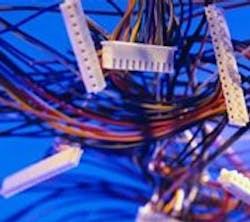Wire and Cable: A No-Brainer?
By John Rezabek, Contributing Editor
With all the varied and complex measurement, control, and network hardware and software the typical automation professional is expected to specify, it would be nice to have a few things that didn't require much stress or scrutiny. Wire and cable once was pretty simple. For point-to-point analog and discretes, we just bought the same thing all the time, without many concerns beyond price and availability. I confess I never gave a lot of thought to the specs. High-speed digital networks changed all that, so a brief look at cable from the inside out might be enlightening.
Aside from the gauge (outside diameter) of the conductors, each conductor can be manufactured as either solid or stranded. Stranded is composed of seven to 50 or more smaller-gauge wires spun together to approximate the same cross section as the solid conductor. I used to think this increased the current-carrying capability, but, in fact, it has little effect. The main reason is flexibility. Minimum bending radius is improved proportionately, as is the tolerance of repeated flexing, like power cords and machine tool cabling.
Stranded conductors can be a real pain when making field terminations using insulation-displacement connectors like the familiar RJ45 (8P8C), but insulation-piercing connectors work better with the stranded variety. The overall gauge of the conductors determines resistance and hence current-carrying capability, but it also affects strength. If you expect some challenging "pulls" during installation, defaulting to the smallest gauge could increase the risk of stretched or broken cables.
Years ago I was interested to learn that most noise reduction/rejection comes not from shielding, but from the "lay of the twist" of twisted-pair cable itself. The technology dates back to Alexander Graham Bell, and cancels noise induced by electromagnetic interference (EMI) by causing it to manifest alternately in each conductor over the length of the twist—effectively canceling it out. Some cables—Cat 5 is a good example—go further and specify different twists-per-inch for each of its pairs. This helps the signals on the different pairs minimize crosstalk over longer runs.
Regarding insulation, the thickness and dielectric strength of the insulator (PVC, for example) determines voltage rating, an empirically validated measure of how much electrical stress the cable can withstand without failing. However, the thickness, composition and uniformity of the insulation also affect a very important property for digital communications, the characteristic impedance at a specified frequency. Cat 5, for example, is supposed to "look like" 100 Ω to a 100 MHz signal. When complex impedance is off or wrong, the digital square wave can be distorted and/or attenuated to the point where zero crossings indicating 1s and 0s are skewed beyond recognition by the receiver (jitter). Too little impedance can make the peak-to-peak voltage too small, causing dropped tokens, packets and retries.
Surprisingly, some majors in the cable manufacturing industry have no established methods to test and certify the capacitance of manufactured cable on the reel. If your project is pushing the limits of a protocol's specification, you might be well served to choose your cable supplier very judiciously, and/or test it thoroughly when it arrives on site.
Then, there's shielding. Individual and/or overall cable shields are specified for increased EMI and radio frequency interference (RFI) for signal-carrying pairs. Braided copper shields are flexible and tolerate more repeated flexing, but braided shields have more gaps where strong EMI can leak through. Foil or Mylar shields provide better overall coverage. They are flexible, but not as tolerant of repeated flexing.
Jackets affect flexibility too. Be sure your cable jackets have a UV-resistant specification if they'll be out in the sun. Their dielectric properties degrade from UV radiation. Jacket and insulation materials also affect the chemical/oil resistance and plenum rating of the cable, so you might be faced with specifying a different cable for indoor runs than those in outdoor raceways.
A few other things to consider. The last time I tried to affix an RJ45 (8P8C) connector to some hardware-store Cat 5 cable, it took me about five tries and 90 minutes to get it right. Cheap consumer-grade cable can have pairs so faintly colored that even those without bifocals will be challenged to get them terminated correctly. Wherever possible, I'm buying made-to-length complete factory assemblies. Cycle-tested standard products are available from most major suppliers, and users can specify a variety of male, female and right-angle connector ends.


